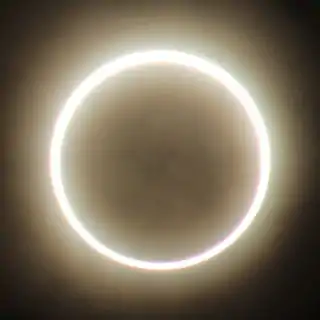Solar eclipse of March 10, 2100
An annular solar eclipse will occur on March 10, 2100. A solar eclipse occurs when the Moon passes between Earth and the Sun, thereby totally or partly obscuring the image of the Sun for a viewer on Earth. An annular solar eclipse occurs when the Moon's apparent diameter is smaller than the Sun's, blocking most of the Sun's light and causing the Sun to look like an annulus (ring). An annular eclipse appears as a partial eclipse over a region of the Earth thousands of kilometers wide. The path of annularity will move from Indonesia at sunrise, over the islands of Hawaii and Maui around noon, and through the northwestern United States at sunset.
| Solar eclipse of March 10, 2100 | |
|---|---|
 Map | |
| Type of eclipse | |
| Nature | Annular |
| Gamma | 0.3077 |
| Magnitude | 0.9338 |
| Maximum eclipse | |
| Duration | 449 sec (7 m 29 s) |
| Coordinates | 12°N 162.4°W |
| Max. width of band | 257 km (160 mi) |
| Times (UTC) | |
| Greatest eclipse | 22:28:11 |
| References | |
| Saros | 141 (28 of 70) |
| Catalog # (SE5000) | 9733 |
The eclipse will be visible over Indonesia and Pacific Ocean west of the International Date Line, on the morning of Thursday, March 11, 2100, and the Pacific Ocean east of International Date Line and North America on the afternoon of Wednesday, March 10, 2100. The path of annularity will be visible in those locations.
Related eclipses
Solar eclipses 2098–2100
This eclipse is a member of a semester series. An eclipse in a semester series of solar eclipses repeats approximately every 177 days and 4 hours (a semester) at alternating nodes of the Moon's orbit.[1]
| Solar eclipses 2098–2100 | |||||
|---|---|---|---|---|---|
| 121 | April 1, 2098 Partial |
126 | September 25, 2098 Partial | ||
| 131 | March 21, 2099 Annular |
136 | September 14, 2099 Total | ||
| 141 | March 10, 2100 Annular |
146 | September 4, 2100 Total | ||
Inex series
This eclipse is a part of the long period inex cycle, repeating at alternating nodes, every 358 synodic months (≈ 10,571.95 days, or 29 years minus 20 days). Their appearance and longitude are irregular due to a lack of synchronization with the anomalistic month (period of perigee). However, groupings of 3 inex cycles (≈ 87 years minus 2 months) comes close (≈ 1,151.02 anomalistic months), so eclipses are similar in these groupings.
| Inex series members between 1901 and 2100: | ||
|---|---|---|
 July 9, 1926 (Saros 135) |
 June 20, 1955 (Saros 136) |
 May 30, 1984 (Saros 137) |
 May 10, 2013 (Saros 138) |
 April 20, 2042 (Saros 139) |
 March 31, 2071 (Saros 140) |
 March 10, 2100 (Saros 141) |
||
References
- van Gent, R.H. "Solar- and Lunar-Eclipse Predictions from Antiquity to the Present". A Catalogue of Eclipse Cycles. Utrecht University. Retrieved 6 October 2018.
External links
- Earth visibility chart and eclipse statistics Eclipse Predictions by Fred Espenak, NASA/GSFC
.jpg.webp)

